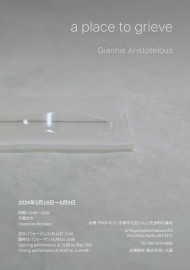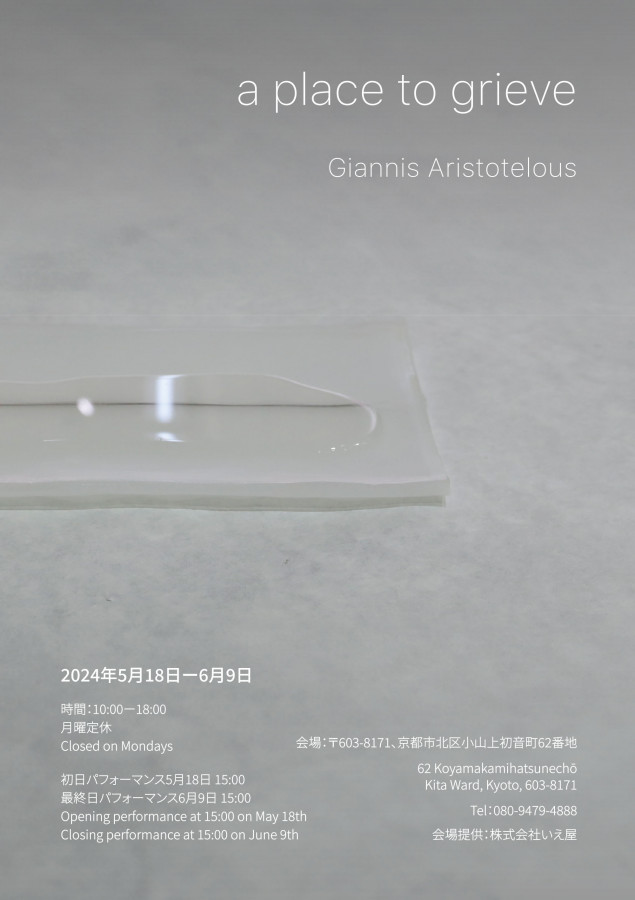2024.05.20
- 展覧会
- 近畿圏
a place to grieve
2024. 05/18 (土)
2024. 06/09 (日)
10:00
18:00
〒603-8171 京都市北区小山初音町62番地
京都市北区小山初音町62番地
MAP
修了生個展のお知らせ|a place to grieve|ヤンニス・アリストテルス (Giannis Aristotelous)
a place to grieve
この度、ヤンニス・アリストテルス(Giannis Aristotelous)は日本での初個展となる今回の展示で、 絵画とインスタレーションを融合させた死と未知なるものへの瞑想を試みます。「a place to grieve」では、化学分解による酸化と劣化のプロセスを虚無のメタファーとして扱い、物の相互作用における感覚的な質に焦点を当てます。
本展の一連の作品は、流動性の高い液体から感知が触発される環境を参照とし、物と人間の緊迫した静かな相互作用から生まれる物語を中心に展開します。また、アリストテルスは自身の作品を通して「もの派」の概念を拡張させ、人間と物の残骸に新しい精神的統一感を生み出すことで物質との新たな関係を試み、新たな空間のあり方を展開します。これはある意味で、既成概念の中に新たなオブジェクトが追加されることで、異なる対話に焦点を当てさせるダダイズムと共通しています。今回の展示では、アリストテルスは物質を生命体として捉え、その特性を活かすことで変化を生み出します。 彼は物質と光や風、水、地球との関係性を探求し、無形で目に見えない相互作用に声を与え、残された物質の気配と私たちの存在に焦点を当てていきます。
作品の大きさは様々ですが、全て人体や箱、床に開いた穴との関係を考慮しています。閉ざされた展示空間では、もはやそこにない行為の痕跡をたどり、存在しないものの気配を呼び起こします。
水は生命の儚さを象徴する根源的な物質で、常に違う様相を見せます。光と組み合わさることで、水はさらに儚くなり、形のない要素を見せます。アリストテルスは、水の形を持たない様相を利用し、展覧会が開催される2つの廃屋を繋ぎます。水が外の光を取り込むことで、その場ならではの雰囲気を醸し出します。アリストテルスが用意した水面が物に一体感を与え、瞑想的な空間を生み出します。
展覧会のオープニングとクロージングではパフォーマンスを行い、水、光、空間とのスピリチュアルな体験をお楽しみいただきます。
ヤンニス・アリストテルスはギリシャ系キプロス人で、京都を拠点に大規模な絵画やインスタレーションを制作しています。ニューカッスル大学(イギリス)、ウィーン応用美術大学(オーストリア) 美術学士課程を卒業後、京都芸術大学大学院芸術研究科修士課程を修了。
アリストテルスは、ウィーンのアクショニズムに興味を寄せ、特にパフォーマンスにおける空間創造の手法として血を積極的に使う、亡き友人ヘルマン・ニッチュの作品からインスピレーションを得ています。アリストテルスは血を使用することで周囲の環境を繋ぐ、ニッチ ュの物質の破壊と祝祭に興味を持ってきました。アリストテルスはニッチュの作品と日本各地の神道や仏教の式典に共通する、儀式性を見出し、そのさらなる発展を試みます。そのためアリストテルスは、場を活性化させるための媒体として水を使用し、周囲の空間、物、人の存在を繋ぎ、儀式の雰囲気を形成しています。
In his first solo exhibition in Japan, Giannis Aristotelous(ヤンニス・アリストテルス)
has combined painting and installation in a meditation on death and the unknown. ‘A place to grieve’ focuses on the sensuous quality of material interaction through chemical decomposition, the processes of oxidization and pigmentation becomes a metaphor for emptiness.
These series of works revolve around a narrative of charged and quiet interactions between objects and human relationships with reference to the environment, often emanating a sensation through fluid liquid exchanges. In addition, through his work, Aristotelous pushes further the idea of the movement Mono-ha, allowing a new material relationship to develop within a new form of space. Developing a new spiritual unity between human and material remnants. In a way, the work explores the idea of Dadaism where objects are added in unexpected contexts, bringing into focus a different dialogue. In this case, Aristotelous deals with the material as a living organism, allowing it to change while activating its material properties. He investigates their relationship to light, wind, water, and earth, giving voice to their intangible and unseen interactions, focusing on their leftover pigmentation in relation to our presence.
The works vary in size, each work has a considered spatial relationship with the human body, boxes, and holes in the ground. Enclosed spaces evoke traces of a positivity that is no longer there, housing the atmosphere of an object that no longer exists.
Water constantly exhibits different properties, being the fundamental ephemeral substance of life. In combination with light, water becomes even more ephemeral, exhibiting elements of formlessness. It is this formless quality that Aristotelous makes use of to bridge the two abandoned houses where the exhibition is held. Water allows the external light in, emphasizing the deteriorating quality of the building’s structure. Aristotelous’ pools of water bring the spectator into a contemplative space, forming a sense of material unity.
The exhibition will open and close with a performance, allowing the spectators to experience the spiritual properties of water, light, and space.
Giannis Aristotelous is a Greek Cypriot artist based in Kyoto where he mainly works with large-scale painting and installation. His academic background includes master’s in Art from Kyoto University of the Arts, Japan and Bachelor’s in Art from Newcastle University, United Kingdom and University of Applied Arts Vienna, Austria.
Aristotelous takes inspiration from Viennese Actionism, specifically the work of his late friend
Hermann Nitsch(ヘルマン・ニッチュ)who actively used blood in his performances as a
way of creating space. Aristotelous has been interested in Nitsch’s material destruction and celebration, connecting the surrounding environment with the use of blood. Through this way, Aristotelous has been interested in the rituals between Nitsch’s work and the Shinto/Buddhist ceremonies he has observed around Japan, wanting to push them further. Therefore, Aristotelous has been using the element of water as an activating material, forming a sense of ritual that forms a connection between the surrounding space, materials, and human presence.
この度、ヤンニス・アリストテルス(Giannis Aristotelous)は日本での初個展となる今回の展示で、 絵画とインスタレーションを融合させた死と未知なるものへの瞑想を試みます。「a place to grieve」では、化学分解による酸化と劣化のプロセスを虚無のメタファーとして扱い、物の相互作用における感覚的な質に焦点を当てます。
本展の一連の作品は、流動性の高い液体から感知が触発される環境を参照とし、物と人間の緊迫した静かな相互作用から生まれる物語を中心に展開します。また、アリストテルスは自身の作品を通して「もの派」の概念を拡張させ、人間と物の残骸に新しい精神的統一感を生み出すことで物質との新たな関係を試み、新たな空間のあり方を展開します。これはある意味で、既成概念の中に新たなオブジェクトが追加されることで、異なる対話に焦点を当てさせるダダイズムと共通しています。今回の展示では、アリストテルスは物質を生命体として捉え、その特性を活かすことで変化を生み出します。 彼は物質と光や風、水、地球との関係性を探求し、無形で目に見えない相互作用に声を与え、残された物質の気配と私たちの存在に焦点を当てていきます。
作品の大きさは様々ですが、全て人体や箱、床に開いた穴との関係を考慮しています。閉ざされた展示空間では、もはやそこにない行為の痕跡をたどり、存在しないものの気配を呼び起こします。
水は生命の儚さを象徴する根源的な物質で、常に違う様相を見せます。光と組み合わさることで、水はさらに儚くなり、形のない要素を見せます。アリストテルスは、水の形を持たない様相を利用し、展覧会が開催される2つの廃屋を繋ぎます。水が外の光を取り込むことで、その場ならではの雰囲気を醸し出します。アリストテルスが用意した水面が物に一体感を与え、瞑想的な空間を生み出します。
展覧会のオープニングとクロージングではパフォーマンスを行い、水、光、空間とのスピリチュアルな体験をお楽しみいただきます。
ヤンニス・アリストテルスはギリシャ系キプロス人で、京都を拠点に大規模な絵画やインスタレーションを制作しています。ニューカッスル大学(イギリス)、ウィーン応用美術大学(オーストリア) 美術学士課程を卒業後、京都芸術大学大学院芸術研究科修士課程を修了。
アリストテルスは、ウィーンのアクショニズムに興味を寄せ、特にパフォーマンスにおける空間創造の手法として血を積極的に使う、亡き友人ヘルマン・ニッチュの作品からインスピレーションを得ています。アリストテルスは血を使用することで周囲の環境を繋ぐ、ニッチ ュの物質の破壊と祝祭に興味を持ってきました。アリストテルスはニッチュの作品と日本各地の神道や仏教の式典に共通する、儀式性を見出し、そのさらなる発展を試みます。そのためアリストテルスは、場を活性化させるための媒体として水を使用し、周囲の空間、物、人の存在を繋ぎ、儀式の雰囲気を形成しています。
In his first solo exhibition in Japan, Giannis Aristotelous(ヤンニス・アリストテルス)
has combined painting and installation in a meditation on death and the unknown. ‘A place to grieve’ focuses on the sensuous quality of material interaction through chemical decomposition, the processes of oxidization and pigmentation becomes a metaphor for emptiness.
These series of works revolve around a narrative of charged and quiet interactions between objects and human relationships with reference to the environment, often emanating a sensation through fluid liquid exchanges. In addition, through his work, Aristotelous pushes further the idea of the movement Mono-ha, allowing a new material relationship to develop within a new form of space. Developing a new spiritual unity between human and material remnants. In a way, the work explores the idea of Dadaism where objects are added in unexpected contexts, bringing into focus a different dialogue. In this case, Aristotelous deals with the material as a living organism, allowing it to change while activating its material properties. He investigates their relationship to light, wind, water, and earth, giving voice to their intangible and unseen interactions, focusing on their leftover pigmentation in relation to our presence.
The works vary in size, each work has a considered spatial relationship with the human body, boxes, and holes in the ground. Enclosed spaces evoke traces of a positivity that is no longer there, housing the atmosphere of an object that no longer exists.
Water constantly exhibits different properties, being the fundamental ephemeral substance of life. In combination with light, water becomes even more ephemeral, exhibiting elements of formlessness. It is this formless quality that Aristotelous makes use of to bridge the two abandoned houses where the exhibition is held. Water allows the external light in, emphasizing the deteriorating quality of the building’s structure. Aristotelous’ pools of water bring the spectator into a contemplative space, forming a sense of material unity.
The exhibition will open and close with a performance, allowing the spectators to experience the spiritual properties of water, light, and space.
Giannis Aristotelous is a Greek Cypriot artist based in Kyoto where he mainly works with large-scale painting and installation. His academic background includes master’s in Art from Kyoto University of the Arts, Japan and Bachelor’s in Art from Newcastle University, United Kingdom and University of Applied Arts Vienna, Austria.
Aristotelous takes inspiration from Viennese Actionism, specifically the work of his late friend
Hermann Nitsch(ヘルマン・ニッチュ)who actively used blood in his performances as a
way of creating space. Aristotelous has been interested in Nitsch’s material destruction and celebration, connecting the surrounding environment with the use of blood. Through this way, Aristotelous has been interested in the rituals between Nitsch’s work and the Shinto/Buddhist ceremonies he has observed around Japan, wanting to push them further. Therefore, Aristotelous has been using the element of water as an activating material, forming a sense of ritual that forms a connection between the surrounding space, materials, and human presence.
| 費用 | なし |
|---|---|
| 定員 | なし |
| 申込方法 | なし |
| 主催 | ヤンニス・アリストテルス |
| お問合せ | ヤンニス・アリストテルス |
| 関連卒業生 | ヤンニス・アリストテルス (Giannis Aristotelous) 2023年度大学院グローバル・ゼミ修了 |





